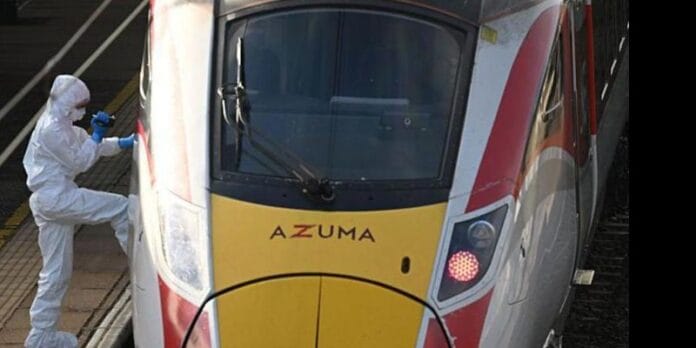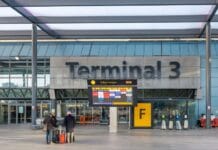A routine Saturday service from Doncaster to London became a mass-casualty scene within minutes. One suspect, six victims, and a heroic member of rail staff fighting for his life later, the incident exposes how knife violence collides with crowded transport and what Britain must do to reduce harm the next time seconds start to matter.
- Primary suspect: A 32-year-old man is being treated as the only suspect.
- Second arrest: A 35-year-old detained at the scene has been released with no further action.
- Casualties: Six people injured. Five discharged; one LNER staff member who intervened remains in a life-threatening condition.
- Police assessment: The staff member’s actions were “nothing short of heroic” and “undoubtedly saved many lives.”
- Response: After passenger 999 calls (≈19:40 GMT), the 18:25 service was diverted to Huntingdon, where armed officers boarded within minutes.
- Eyewitnesses: Reports of panic, trampling, improvised first-aid, and a suspect being Tasered on the platform.
A Tight Timeline
- Onboard escalation: Passengers report a man moving through carriages with a large knife; alarms raised.
- Driver’s decision: The driver requests a switch from fast to slow lines and targets Huntingdon, a platformed stop with quick police access.
- Contain and board: Doors opened; armed officers boarded rapidly; a knife recovered at the scene; one suspect detained.
- Immediate care: Passengers and crew applied pressure to wounds; paramedics treated and evacuated the injured.
Why this mattered: Converting a moving train into a controlled, platformed scene shaved critical minutes off police and clinical response. In mass-injury events, minutes become policy.
What Worked
- Crew discipline & communications: Calm instructions, carriage lockdowns, and clear announcements reduced chaos.
- Routing to a platform: Enabled simultaneous police entry and medical access—an essential but often under-appreciated capability.
- Courage under pressure: The LNER colleague who confronted the attacker almost certainly changed the casualty count.
What Didn’t
- Confined crowd dynamics: Carriage density amplified risk—panic, trampling, and line-of-sight confusion.
- Ad-hoc first aid: Passengers helped bravely, but bleed control kits and training are not yet universal on long-distance services.
- Information fog: Early misidentification of a second person (since cleared) shows how chaotic scenes can skew initial reports. That’s normal—but it argues for better camera coverage and escalation tooling.
Knife Harm Meets Mass Transit
The incident sits on the same curve as Britain’s wider knife-harm problem—but with transport-specific stakes:
- Weapon reality: Most serious attacks involve readily available domestic blades as often as purpose-built “combat” knives. Curbing only the latter leaves a wide gap.
- Contagion risk: Highly publicised incidents can trigger short-term mimicry; mainline routes into London on weekends and match-days are predictable high-risk windows.
- Duty of care: Transport hubs carry crowds, queues, and confined spaces. That calls for bleed-readiness and faster incident digitisation (live camera pulls, instant incident beacons to BTP).
Five Concrete Fixes
- Bleed-Ready Trains & Stations
- Place two trauma kits per train (CAT tourniquets, hemostatic gauze, chest seals) and public bleed cabinets at major stations—treated like defibs.
- Train all onboard staff in catastrophic haemorrhage control; refresh annually.
- Camera & Connectivity Standards
- Audit rolling-stock cameras for no blind spots between vestibules, buffet, and end gangways.
- Enable a live video downlink to BTP when the emergency handle or driver’s red button is triggered.
- Crisis Comms Macros
- Pre-scripted, plain-English PA messages to reduce stampedes, direct passengers to lockable carriages, and prepare for platformed boarding by police.
- Hot-Route Policing
- Data-led BTP surge patrols on evening/weekend services feeding high-footfall stations, coordinated with match schedules and event calendars.
- Staff Protection & Aftercare
- Clear “green-light” authority for staff intervention; stab-resistant gloves for responders; guaranteed post-incident counselling and compensation pathways.
Human Courage at the Centre
- The LNER colleague who stepped between a blade and strangers is in intensive care; their bravery must be met with lasting institutional support.
- The driver’s composure turned chaos into an orderly rescue lane.
- Passengers who pressed on wounds and calmed others turned fear into function.
Heroism deserves headlines; system design deserves the budget.
What We Still Don’t Know
- The suspect’s motive and full timeline before boarding at Peterborough.
- Whether any prior risk markers (police, health, or social) could have triggered earlier intervention.
- How quickly the first bleed control was applied—and where equipment was (or wasn’t) available on this service.
These answers matter because they shape procedures, not just a narrative
Britain cannot arrest its way out of knife harm, and no rail operator can harden every inch of a train. But we can minimise lethality: put lifesaving gear where the injuries happen, wire trains so police can see in, drill drivers and crews to buy time, and surge BTP where crowds and grievance concentrate. The lesson of Huntingdon is not only bravery; it’s time-discipline. We owe the next victims fewer lost seconds.




